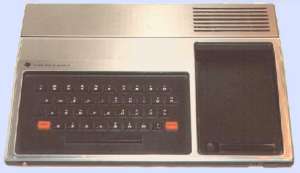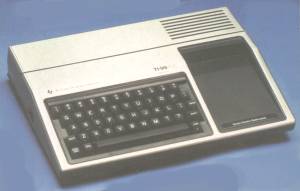
The TI 99/4

The TI 99/4A
|
Manufacturer |
Texas Instruments (US) |
Model |
TI 99/4
TI 99/4A
(99 from the processor, 4 because it had four display modes.) |
Date Launched |
June 1979 (TI 99/4)
June 1981 (TI 99/4A) |
Price |
Approx £900 (TI 99/4 with monitor)
£340 (TI 99/4A without monitor)
The TI 99/4A eventually dropped to as little as £90. |
Microprocessor type |
TMS 9900 @ 3.3 MHz
(A 16-bit stack based processor) |
ROM size |
26 kilobytes |
Standard RAM |
16 kilobytes, plus 256 bytes of fast 'scratchpad' RAM used by the processor as its registers. |
Maximum RAM |
48 kilobytes |
Keyboard type |
Large calculator-style keys (TI 99/4)
Typewriter-style (TI 99/4A) |
Supplied language |
TI BASIC
An extended BASIC was available on cartridge.
The TI-99/4 (but not 99/4A) also had an 'Equation Calculator' so it could be used like a pocket calculator. |
Text resolution |
32 x 24 or 40 x 24 characters |
Graphics resolution |
256 x 192 pixels |
Colours available |
16 |
Sound |
3 channels through internal speaker |
Cassette load speed |
450 baud |
Dimensions (mm)
Weight (grams) |
381 x 259 x 71
1800 (TI 99/4A) |
Special features |
Most software came as plug-in ROM cartridges.
Wide range of peripherals, including a speech synthesizer similar to that used in Texas Instruments' 'Speak and Spell' toy. |
Good points |
Excellent graphics, sound and hardware capabilities by 1979 standards.
High quality construction. |
Bad points |
Both models were too expensive when first launched.
The BASIC had originally been written for a different processor (the 9985 which the TI 99/4 had been intended to use but which did not work properly) and needed two stages of interpretation. This made it very slow. (Extended BASIC corrected this.)
Texas Instruments expected software developers to buy a licence, which gave them access to documentation on the TI 99/4, and then pay royalities to TI. Little information on the graphics or operating system was freely available.
The result was that software was expensive and there was less choice than for other home computers. |
How successful? |
Did not sell particularly well in the UK, though the 99/4A was very popular in America, and over 2 million were produced.
If it had been more reasonably priced in 1980/81 it may have been an even greater success but by the time the TI 99/4A had fallen to a reasonable price of £150 in 1983 it was looking old fashioned and had little software compared to Sinclair, Commodore and Atari alternatives.
To maintain sales, especially against the Commodore 64 in the US, Texas Instruments had to cut the price of the TI 99/4A to the point where it was no longer profitable, and they dropped out of the home computer market in early 1984. |
Comments |
The two models can be distinguished by their keyboards.
The original TI 99/4 had only an NTSC television output, unsuitable for British televisions, and thus had to be supplied with a monitor which increased the price. The keyboard was very poor and the display lacked lower-case letters.
The TI 99/4A was the improved version, with a PAL UHF modulator in the UK so that it could be connected directly to a standard television, plus a proper keyboard and lower-case characters.
To try to compete at the entry-level end of the market, in 1983 Texas Instruments designed the TI 99/2 which was intended to sell for $100. It was a drastically cut-down TI 99/4 with only 4KB of RAM, no sound, no colour, reduced BASIC and incompatible with TI 99/4 cartridges. Really it is hard to imagine that anyone would have bought such a machine in 1983. In the event the price of the TI 99/4A had by this time been reduced to close to $100 and the 99/2 was never launched.
Review of the TI-99/4
Advertising brochure for the TI-99/4 |

